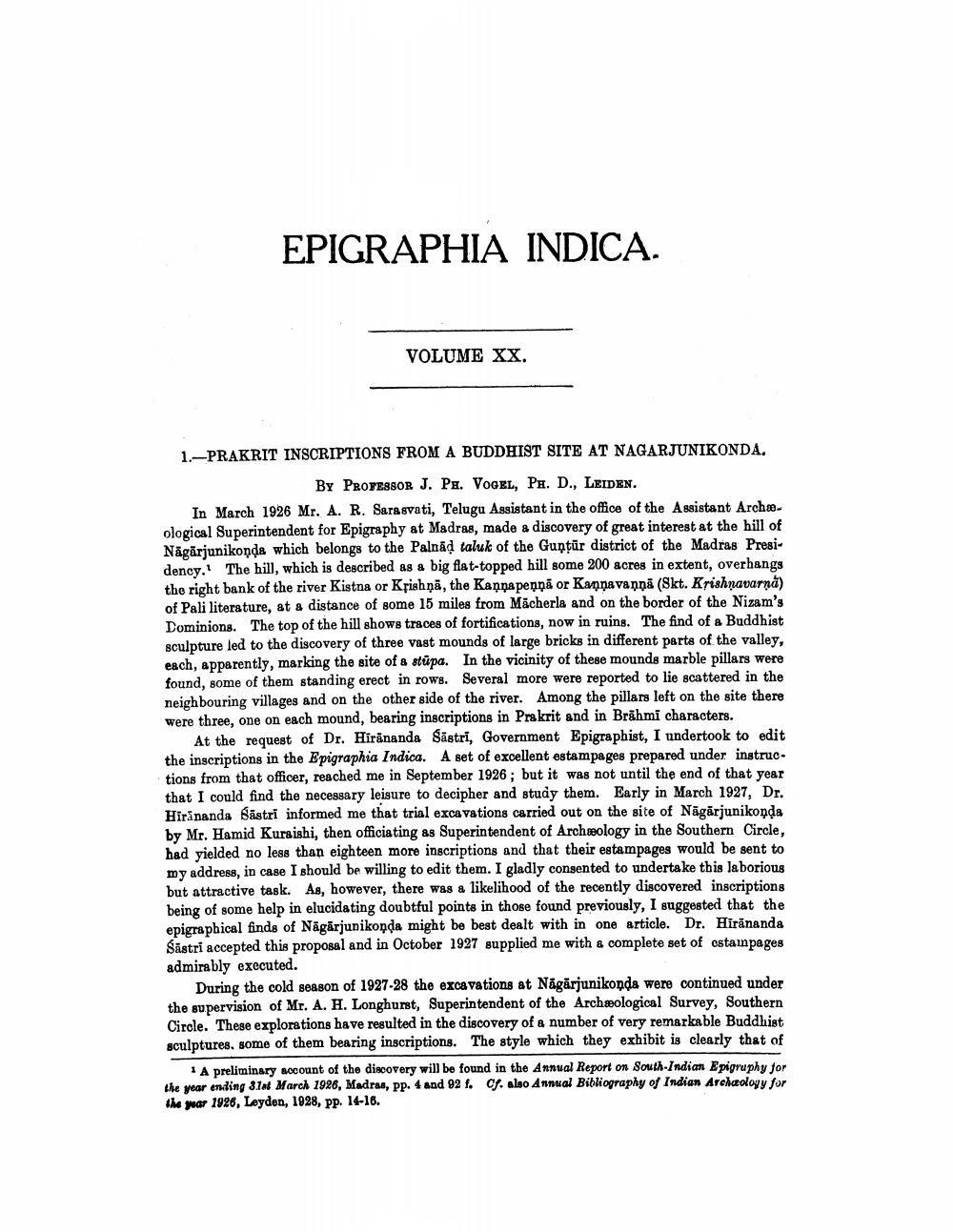________________
EPIGRAPHIA INDICA.
VOLUME XX.
1.-PRAKRIT INSCRIPTIONS FROM A BUDDHIST SITE AT NAGARJUNIKONDA.
BY PROFESSOR J. PH. VOGEL, PH. D., LEIDEN.
In March 1926 Mr. A. R. Sarasvati, Telugu Assistant in the office of the Assistant Archeological Superintendent for Epigraphy at Madras, made a discovery of great interest at the hill of Nagarjunikonda which belongs to the Palnaḍ taluk of the Guntur district of the Madras Presidency. The hill, which is described as a big flat-topped hill some 200 acres in extent, overhangs the right bank of the river Kistna or Krishna, the Kannapeņņā or Kannavanņā (Skt. Krishnavarna) of Pali literature, at a distance of some 15 miles from Macherla and on the border of the Nizam's Dominions. The top of the hill shows traces of fortifications, now in ruins. The find of a Buddhist sculpture led to the discovery of three vast mounds of large bricks in different parts of the valley, each, apparently, marking the site of a stupa. In the vicinity of these mounds marble pillars were found, some of them standing erect in rows. Several more were reported to lie scattered in the neighbouring villages and on the other side of the river. Among the pillars left on the site there were three, one on each mound, bearing inscriptions in Prakrit and in Brahmi characters.
At the request of Dr. Hirananda Sastri, Government Epigraphist, I undertook to edit the inscriptions in the Epigraphia Indica. A set of excellent estampages prepared under instructions from that officer, reached me in September 1926; but it was not until the end of that year that I could find the necessary leisure to decipher and study them. Early in March 1927, Dr. Hirananda Sastri informed me that trial excavations carried out on the site of Nagarjunikonda by Mr. Hamid Kuraishi, then officiating as Superintendent of Archaeology in the Southern Circle, had yielded no less than eighteen more inscriptions and that their estampages would be sent to my address, in case I should be willing to edit them. I gladly consented to undertake this laborious but attractive task. As, however, there was a likelihood of the recently discovered inscriptions being of some help in elucidating doubtful points in those found previously, I suggested that the epigraphical finds of Nagarjunikonda might be best dealt with in one article. Dr. Hirananda Sastri accepted this proposal and in October 1927 supplied me with a complete set of estampages admirably executed.
During the cold season of 1927-28 the excavations at Nagarjunikonda were continued under the supervision of Mr. A. H. Longhurst, Superintendent of the Archaeological Survey, Southern Circle. These explorations have resulted in the discovery of a number of very remarkable Buddhist sculptures, some of them bearing inscriptions. The style which they exhibit is clearly that of
1 A preliminary account of the discovery will be found in the Annual Report on South-Indian Epigraphy for the year ending 31st March 1926, Madras, pp. 4 and 92 f. Cf. also Annual Bibliography of Indian Archaeology for the year 1926, Leyden, 1928, pp. 14-16.




